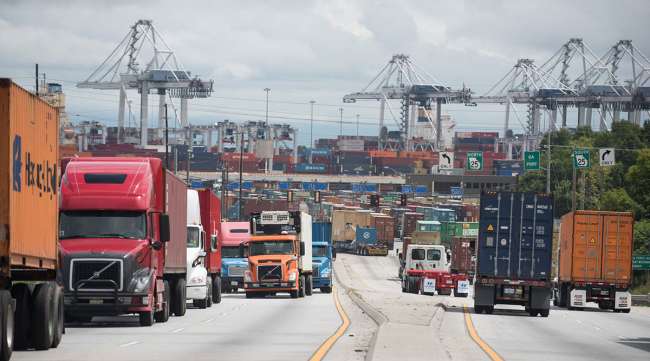The Atlanta Journal-Constitution
Planned Savannah Private Port Terminal Stokes Traffic Fears

[Stay on top of transportation news: Get TTNews in your inbox.]
SAVANNAH, Ga. — Cargo ships aren’t the only traffic the planned SeaPoint marine terminal east of downtown Savannah will attract once the industrial complex is developed and opens.
How the facility’s eventual anchor tenant moves cargo in and out of the 226-acre site is a major concern, multiple local officials said. SeaPoint’s owner, Savannah industrialist Reed Dulany, is building a half-mile-long wall for a ship dock on the property and marketing it to a variety of users, including cargo traders and manufacturers. Developing the property is expected to take until at least 2027.
The potential for SeaPoint to produce significant truck and train traffic presents a challenge for Dulany, the eventual user and the Savannah community. To get to I-16 and I-95, trucks leaving SeaPoint would have to drive through Savannah’s city center with no direct access to the interstates except via local roads. The rail line that would service SeaPoint cuts through the heart of several residential neighborhoods, crossing streets at 24 points in a 2-mile stretch.
Truck and train traffic from existing facilities neighboring SeaPoint have long caused consternation for residents and prompted debate and even legislative action from government bodies. The Georgia Ports Authority cited concerns about port-related traffic overwhelming the streets and tracks as the primary reason for its decision to abandon plans for a container terminal on the site in 2017 and for its push to block development of a private container facility on the site in 2022.
Dulany has conducted a traffic analysis, but not a comprehensive study related to the site, and he has had only informal discussions with Savannah city government staff on the potential impact, the last coming in September 2021. Mayor Van Johnson, who in 20 years on Savannah City Council has often dealt with east-west traffic issues, insists on the development of a “solution before there is a problem” when it comes to SeaPoint.
“We definitely want economic development, but we must preserve livability,” he said.
Savannah City Manager Jay Melder, the city’s top administrator, echoed the mayor’s sentiments and the need to support “high-impact economic development that brings jobs and opportunities to our residents” while also being mindful of traffic’s impact on quality of life.
The location of SeaPoint's industrial site near the Port of Savannah.
“This is a central issue that must be addressed first, before any big plans are set in stone,” Melder said.
But Dulany said the angst over SeaPoint-related trucks and trains is premature. Without a tenant, it’s unknown how much traffic the site will generate. In addition, he’s suggested several impact-reducing initiatives, such as appointment gate departures to space out cargo-carrying trucks on the roads and the development of an inner harbor barge network, known in the industry as a “blue highway,” that would move cargo via water to a distribution point upriver.
Even so, as sitework ramps up at SeaPoint — the seawall installation should start later this year — concerns about traffic will persist even as the site brings promise as a job creator and tax revenue boon. A University of Georgia study estimated the site could accommodate a user employing 1,700 workers, and Dulany projects a minimum $2 billion investment.
Count Savannah Economic Development Authority CEO and President Trip Tollison among those adamant that SeaPoint, which he’s labeled a “monumental project,” addresses traffic concerns.
“Whatever happens on the site there needs to be close coordination with local governments on planning and transportation,” he said. “Conversations need to be had.”
Crosstown Conundrum
Savannahians often joke that the city’s last intelligent road planner was Gen. James Oglethorpe, who designed the original street grid in the horse-and-carriage days of the 1730s.
Almost 300 years later, Savannah has two north-south highways that bracket the city but no east-west corridor. Truck traffic moves across town via Bay Street, which cuts through the Historic District and passes in front of City Hall; on DeRenne Avenue, which bisects multiple residential neighborhoods and is home to two of the city’s three hospitals; or out Abercorn Street Extension, a 10-mile route lined by retail stores and traffic lights.
How does hydrogen fuel cell technology fit into freight transportation? Find out with Parker Meeks, the CEO of Hyzon, a company that designs and manufactures fuel cell technology for heavy-duty transport applications. Tune in above or by going to RoadSigns.ttnews.com.
The Ports Authority has conducted three traffic studies related to SeaPoint, including one in response to Dulany negotiating with a private container terminal operator for the site in 2022. The authority was able to quash that deal by challenging SeaPoint’s site permit with the U.S. Army Corps of Engineers and by stoking concerns about the potential terminal with the prospective tenant.
Ports Authority President and CEO Griff Lynch said the much-larger terminal the authority initially planned for SeaPoint would have required $1.7 billion in road improvements, highlighted by construction of an elevated highway above DeRenne Avenue. An updated study looking at a lower-capacity terminal, such as the one marketed by Dulany in the years since the authority abandoned its SeaPoint project in 2017, still identifies DeRenne and other east-west corridors as major chokepoints and public safety risks.
The report estimates a SeaPoint cargo terminal would mean 4,000 to 10,000 more trucks a day, depending on the user, and “bring Derenne Avenue, President Street, Abercorn Street and Bay Street to practically a standstill,” the Ports Authority said in a statement.
In a report to the corps dated Feb. 9, 2023, Dulany makes a different truck traffic pitch. He projects the site producing about 3,000 truck trips per day and his proposed appointment gate system would result in truck traffic similar to that of a prior user of the site, a chemical processor.
Staggering truck departures and implementing the barge system would address traffic concerns, Dulany said.
“In reality, if the GPA wanted to do what is best for Savannah, the environment and the taxpayers, it would have utilized SeaPoint as a transload area for big ships and then used electric barges — a blue highway — to transfer the containers upriver to a depot for overland distribution,” he said.
Barges and Bridges
A barge network is an increasingly popular maritime trade trend.

The SeaPoint facility is planned downriver to the east of the Talmadge Memorial Bridge. (Curtis Compton/Atlanta Journal-Constitution via Tribune Content Agency)
European ports such as Rotterdam, in the Netherlands, and Antwerp, in Belgium, use blue highways. U.S. East Coast epicenters such as New York and Charleston, S.C., are exploring how to better use waterways rather than roadways.
Barging is an option for Savannah, Dulany said, because the river goes from busy to desolate once it passes the Ports Authority’s Garden City Terminal. The Savannah River is largely navigable for shallow draft vessels between Savannah and Augusta, a distance of nearly 200 miles.
Lynch dismisses the blue highway idea, calling it inefficient. Crane lifts are the priciest part of port operations, and moving cargo from a ship to shore and then from shore to barge and ultimately barge to shore again is expensive.
Yet, Dulany says those costs pale in comparison to the billions the authority needs to build an additional container terminal and replace the Talmadge Memorial Bridge rather than use SeaPoint. The iconic cable-stayed bridge is too low to allow the biggest containerships on the ocean to access the authority’s terminals, while developing SeaPoint for containers and implementing a blue highway would eliminate the need for a new terminal and bridge.
The Ports Authority’s Lynch disputes the notion that SeaPoint is a panacea, saying the river near SeaPoint is not wide enough to turn the massive ships it sees — some as long as 1,300 feet — and they would need to sail upriver and under the bridge to the Ports Authority’s turning basin to spin around.
Authority Terminal Traffic
The debate over SeaPoint and traffic has focused new attention on road and rail congestion related to two Ports Authority terminal projects.
Want more news? Listen to today's daily briefing above or go here for more info
The authority recently filed for a permit to build a facility on Hutchinson Island, located in the middle of the Savannah River. The application does not include a truck or train study, but Lynch said those reviews are underway and will be included with the submission before the corps grants approval. The terminal is likely to demand significant infrastructure improvements along U.S. 17 between Savannah and Hardeeville, S.C., where U.S. 17 connects to I-95.
The rail line servicing the site, which was decommissioned decades ago, would also need investment and runs through the Savannah National Wildlife Refuge.
The Hutchinson Island Terminal would be located directly across the Savannah River shipping channel from another Ports Authority site, Ocean Terminal. That facility has long handled several types of cargo but is currently being retrofitted as a container-only venue.
The authority has already moved to address increased traffic from Ocean Terminal. The entity’s board approved funds last week to build an overpass linking the site directly to U.S. 17 to minimize the impact on nearby neighborhoods.
“This flyover will make us more efficient and easy to do business with,” said Kent Fountain, chairman of the Ports Authority’s board. “The real aim was to sustain our community. We could have done something cheaper, but this was the right thing to do.”
Distributed by Tribune Content Agency, LLC





